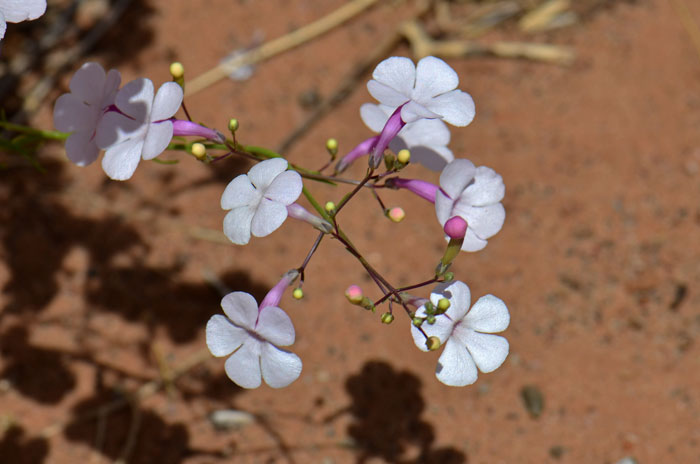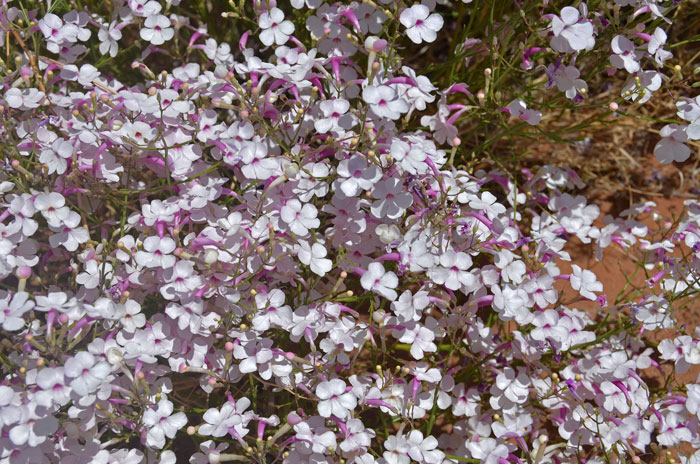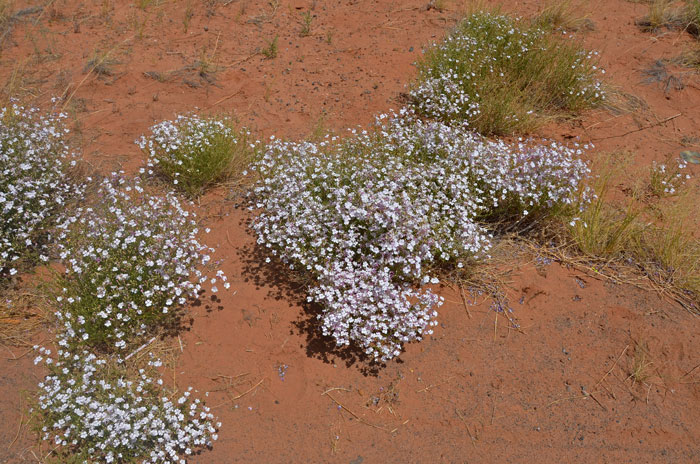Penstemon ambiguus, Gilia Beardtongue




Scientific Name: Penstemon ambiguus
Common Name: Gilia Beardtongue
Also Called: Bush Penstemon, Gilia Penstemon, Pink Plains Beardtongue, Pink Plains Penstemon, Sand Beardtongue, Sand Penstemon
Family: Scrophulariaceae, Figwort or Snapdragon Family - Moving to Plantaginaceae
Synonyms: ()
Status: Native
Duration: Perennial
Size: Up to 3 feet tall.
Growth Form: Forb/herb, subshrub; plants mounded in profile, multiple fine stems, bases woody.
Leaves: Green; opposite, very narrow, thread-like.
Flower Color: Pink or whitish-pink; flowers about 1 inch, tubular or salverform, faces flat or pansy-like.
Flowering Season: May to October.
Elevation: 4,500 to 6,500 feet.
Habitat Preferences: Open sandy mesas and grasslands, common in the Painted Desert.
Recorded Range: Penstemon ambiguus is found in the southwestern United States and in CO, KS, OK, WY; AZ, NM, NV, TX, UT. It also occurs Chihuahua, Mexico. In Arizona it is found in Coconino County and the northeastern part of the state in Apache and Navajo counties.
North America & US County Distribution Map for Penstemon ambiguus.
U.S. Weed Information: No information available.
Invasive/Noxious Weed Information: No information available.
Wetland Indicator: No information available.
Genus Information: In North America there are 250 species and 393 accepted taxa overall for Penstemon. World wide, The Plant List includes 301 accepted species names and includes a further 188 infraspecific rank for the genus.
In the Southwestern United States, Arizona there are 43 species of Penstemon, in California there are 55 species, Nevada has 50 species, New Mexico has 47 species, Texas has 24 species, Utah has 73 species. All data is approximate and subject to taxonomic changes.
There are 2 varieties in Penstemon ambiguus;
Penstemon ambiguus var. ambiguus, Gilia Beardtongue, (CO, KS, NM, OK, TX);
Penstemon ambiguus var. laevissimus, Pink Plains Beardtongue (AZ, CO, NM, NV, UT, WY, TX).
Comments: The plants in the photos above were taken June 17, in northeast Arizona at Monument Valley, Arizona. The variety in Arizona is "laevissimus" which has leaves that are more glabrous than the typical plant which has puberulent herbage.
Penstemon ambiguus has been used to indicate when watermelon planting was over and for other purposes by South American indigenous peoples.
Hopi Other, Ceremonial Items, Plant, associated with east direction, used in the Po-wa-mu ceremony.
Hopi Other, Season Indicator, Flowers used to indicate when watermelon planting was over.
Keres, Western Drug, Emetic, Infusion of plant used as an emetic.
Navajo, Kayenta Drug, Dermatological Aid, Plant used for solpugid bites or poultice of plant applied to eagle bites.
Navajo, Kayenta Drug, Disinfectant, Plant used as a fumigant for livestock with snakebites.
Tewa Other, Ceremonial Items, Plant, associated with east direction, used in the Po-wa-mu ceremony
Tewa Other, Season Indicator, Flowers used to indicate when watermelon planting was over.
See ethno-botanical uses at Native American Ethnobotany, University of Michigan, Dearborn.

